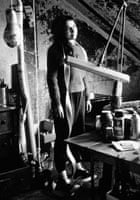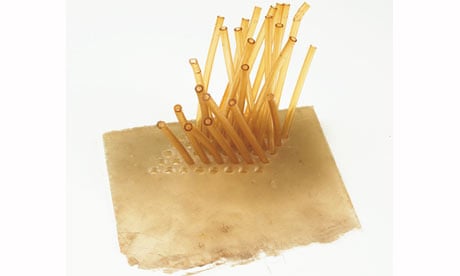The sculptures of Eva Hesse seem almost human – but not in a good way. Latex strips and fleshy protrusions hang limply like flayed skin or mangled limbs. A ragged rope suspended from the ceiling looks like strands of hair yanked from the teeth of a comb. Bent, buckled and scraped into sexually ambiguous forms, Hesse's sculptures are full of fetishistic desire. The cloudy resin and sticky droplets of varnish that she uses to coat her materials harden each protrusion much like a clogged artery. One of the greatest sculptors of the 20th century, she successfully manipulated household materials into objects that were as seductive as treacle but as repulsive as a wound.
Hesse was the antidote to the macho school of minimalist sculpture in the 1960s. Her sculptures were sensual, all curved lines and soft fabrics, or papery thin and fragile, at odds with the rust and raw power of Carl Andre or the clean conceptual order of an artist like Sol LeWitt. Yet her inspirations were similar. Like them she strove to make sense of the industrial world around her, using man-made fibres that could be purchased at any grocer's. Her sculptures created a link for the viewer between humanity's primordial hunger for immortality and the invincible materials they had invented. She made artificial substances like fibreglass and polyester look like hair or sexual organs, and coated them in layers of gluey substances as if she was fossilising human existence in amber.

Born in Hamburg in 1936, Hesse and her family escaped Nazi Germany to the US in 1939. She studied art at the Cooper Union and Yale, before returning to New York to become a painter. In 1964 she and her husband, the sculptor Tom Doyle, moved to Kettwig an der Ruhr in Germany, working in an abandoned textile factory. Here, amid the scraps of material, cord and corroded machine parts, and against the cultural backdrop of cold war politics, Hesse created her first sculptures. They were witty and sexually suggestive, inspired by the erotic surrealism of Marcel Duchamp and Hans Bellmer. She bound papier-mache in cord and hung string bags filled with scrunched polyethylene, so that they dangled like fat, viscous teardrops from the gallery walls.
But Hesse's career was cut short after just 10 years. She died at the age of 34 in 1970 of a brain tumour. The art critic Lucy Lippard said: "Hesse took exactly what she needed from the art around her, transformed it, and gave it back to the art world."
Why we like her: For the early relief Ringaround Arosie (1965), in which electrical wire that spiralled into pointy protrusions was coated in papier-mache and Masonite. The work was to commemorate the news that her friend, Rosie Goldman, was pregnant; the artist described it in a letter to her friend Sol LeWitt as "both breast and penis".
Myth-making: Her premature death led to Hesse being portrayed as something of a tragic heroine. One article even called her "the female James Dean".
Friends and neighbours: When she was 23 she moved to New York, where her next-door neighbours were the painters Robert Ryman and Robert Mangold.
